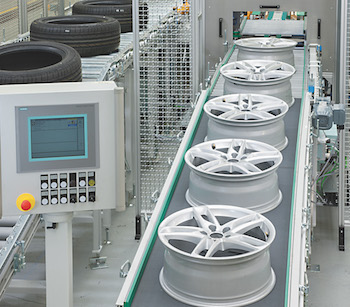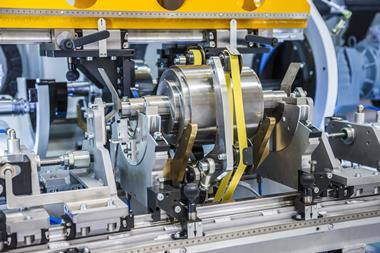
Series production of complete wheelsets in JIT manufacturing operations is one of the decisive process stages in final vehicles assembly
 With its new wheel-tyre assembly line, Schenck RoTec offers both OEMs and main tier one automotive suppliers and tyre wholesalers a flexible, highly scalable and efficient solution for just-in-time (JIT) production. Of record-breaking mixed operation, the fully-automated system produces all wheel-tyre combinations, from 14” (35.5cm) wheelsets for compact vehicles through to 23” wheelsets for premium models. Above all, the flexibility of the inflating machine and the robot-based balancing weight apply set technological standards in the industry.
With its new wheel-tyre assembly line, Schenck RoTec offers both OEMs and main tier one automotive suppliers and tyre wholesalers a flexible, highly scalable and efficient solution for just-in-time (JIT) production. Of record-breaking mixed operation, the fully-automated system produces all wheel-tyre combinations, from 14” (35.5cm) wheelsets for compact vehicles through to 23” wheelsets for premium models. Above all, the flexibility of the inflating machine and the robot-based balancing weight apply set technological standards in the industry.
Today, series production of complete wheelsets in JIT manufacturing operations is one of the decisive process stages in final vehicles assembly. This requires a high level of flexibility from all players. The increasing variety of vehicle models and equipment features in automobile construction by itself requires a greater number of wheel variants. For example, a first tier supplier today has to provide the complete range, from small 14” wheels for city runabouts through to 23” low-profile wheels for premium vehicles. At the same time, increasing quality and safety requirements, such as the integration of modern tyre pressure control systems, bead-seat optimisation or uniformity tests, considerably increases the assembly expense.

With a view to these developments, Schenck RoTec has realised a new complete wheel assembly line that enables OEMs, automotive suppliers and tyre wholesalers to produce a greater variety of versions of wheel/tyre combinations efficiently and also to keep pace with the growing requirements for quality and safety. This is achieved by the intelligent combination of innovative assembly technology, an extremely flexible tyre inflation system, efficient balancing and measuring systems, and a fully-automated unbalance correction station.
Highly efficient mixed operationThe process is started by two driven roller conveyors and an industrial robot that feed the incoming tyres and rims, which are initially separated from each other, and positioned so they can be ‘married’ gently in a high-end assembly machine fully automatically. This is done by the lower tyre bead being drawn onto the rim by a robot, and the upper tyre bead conventionally by a 360° rotation of the mounting head.
After assembly, the tyres, still de-pressurised, run on conveyor belts to be inflated in the Ventuo multi-ring inflation system. The magazine of this unique inflation system stores up to six inflation rings, each of which can be brought into the inflation position in just two seconds. In this way, changing wheel sizes with diameters from 14” to 23” can be done in less than seven seconds. This is a record-breaking time and at present is hard to beat in regard of flexibility.
After the complete wheels are inflated to the correct air pressure, fully automatic tyre seating optimisation takes place in accordance with the functional principle of ‘conical rollers’ or the load drum principle. Here, four inversely head-to-end aligned conical rollers, or a swivelling drum, ensure final stabilisation and optimisation of the tyre bead seating.
Schenck RoTec ensures the high availability of the new complete wheel assembly line with a complete bundle of measures and services. These include, among others, individual maintenance agreements, fingerprint analysis, remote maintenance, or a 24-hour hotline. In addition, the company supports rapid repairs and supplies of consumables and wearing parts with a service team with over 200 technicians.
Subsequent balancing of the wheel is carried out in a customised complete-wheel balancing machine. The wheels’ unbalance is measured here in two planes. The measured values are determined by the CAB 950st, which was optimised specially for complete wheel production, and also makes a recommendation for setting the compensation. This measuring and control appliance convinces not only with its precision, but also with the SmartTouch control concept, which is as simple as it is innovative. The ‘fingerprint’ analysis tool for rapid identification of changes to the system is integrated as standard. This enables temporary monitoring of the complete system and thus fast and targeted reaction to repair or maintenance cases.
 Schenck RoTec’s new wheel-tyre assembly line covers all combinations
Schenck RoTec’s new wheel-tyre assembly line covers all combinationsAttaching balancing weights by robotAs a logical consequence of the determination of the unbalance, the next step is to correct this by attaching special balancing weights to the insides of the rims. Once again, Schenck RoTec sets standards through the consistent full automation of this process stage in a highly innovative unbalance correction station.
With great precision and exactly coordinated to the sequencing of the system as a whole, a robot takes over the balancing weights supplied as endless coils and attaches them precisely to the position on the rim defined by the balancing system with the greatest process reliability.
Modern sensor technology ensures the required pressure to adapt the weight to the rim radius for an optimum fit. Thanks to the robot-guided unbalance correction, it was possible to reduce the system’s cycle time further and in this way to increase the output quantity clearly. The last process step, the final control balance checking of the wheels for minimal residual unbalances, is carried out before the complete wheel leaves production.
Forward-looking overall processDuring the development and realisation of the new complete wheel assembly line Schenck RoTec’s technicians examined every single process step minutely and optimised them through the use of innovative technologies – for example, the Ventuo multi-ring inflation station and the fully automated attachment of correction weights. They have succeeded in designing the exceedingly complex overall assembly process for complete wheel production to be more efficient and safer, and more flexible.
In addition, they have succeeded in lowering the system’s energy consumption clearly at many points and in considerably reducing the space requirements for the complete assembly line. In this way, automotive suppliers and tyre wholesalers are provided with a future-oriented global solution for JIT wheel production with which they can secure their competitive position in the long term.
Based on existing CAB measuring technology and its vibration sensor, Schenck RoTec’s fingerprint system determines a current vibration pattern of the balancing machine. The current condition can be assessed in each case by comparing this snapshot with the data of the initial commissioning. Conclusions regarding the condition of the machine can be drawn in this way, and wear, faults or damage can be identified exactly. Possible problems are detected at an early stage, repairs can be realised foreseeably and predictably. Unexpected outages can be avoided to a great extent, which considerably improves the system’s overall efficiency.
































